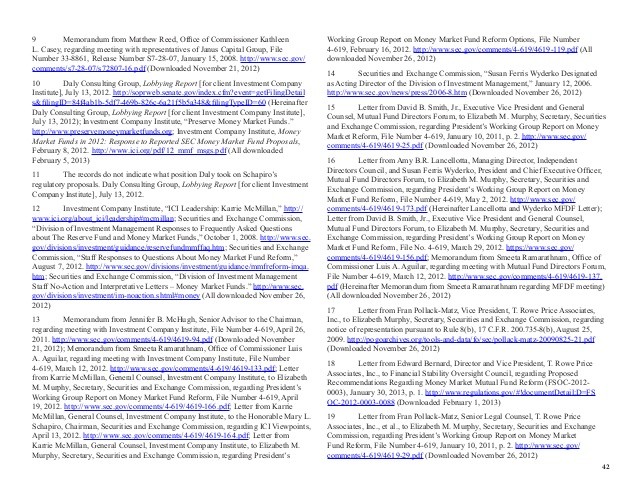SEC s long path to money market fund reform ends in compromise
Post on: 3 Июнь, 2015 No Comment

The U.S. Securities and Exchange Commission logo adorns an office door at the SEC headquarters in Washington, June 24, 2011.
Factbox
WASHINGTON (Reuters) — U.S. regulators adopted moderate reforms for money market mutual funds on Wednesday, in what amounted to a compromise that aims to balance the need to reduce the risk of runs on the funds while still protecting the product’s utility for investors.
The Securities and Exchange Commission’s rule garnered mixed reviews from the industry and even the SEC’s own commissioners, with two voting against it.
The main pillar of the rule requires prime money funds used by institutional investors to float their values, instead of letting them maintain a stable value at $1 per share. The goal is to prevent investors from getting spooked by the prospect of funds breaking the buck, or their net asset value falling below $1 per share.
In addition, fund boards will have discretion to lower gates on redemptions, or charge fees of up to 2 percent if market stress causes a fund’s weekly liquid assets to fall below 30 percent.
Both measures are slated to take effect in two years.
The final adoption of the reforms was the culmination of years of fierce debate, dating back to the financial crisis.
In 2008, the Reserve Primary Fund’s exposure to Lehman Brothers prompted panicked investors to withdraw their money in a run that led the fund to break the buck.
That in turn forced the Federal Reserve temporarily to backstop the $2.6 trillion industry until the chaos subsided.
Republican SEC Commissioner Michael Piwowar and Democrat Kara Stein both dissented on the rule, with Piwowar expressing concerns surrounding the floating NAV and Stein saying she fears the fees and gates may actually fuel more runs.
There has been no shortage of opinions and proposals to address the remaining risks associated with money market funds, SEC Chair Mary Jo White said. Choices must be made and differences will be expressed.
The laundry list of reform possibilities over the years has included an industry-backed liquidity facility, minimum risk balances, capital buffers, a floating NAV and liquidity fees and gates.
The SEC’s final, combination approach got mixed reviews from the industry. From our perspective, not everything in the rule is what we had hoped for, but at a very high level, it is also along the lines of what we are advocating for, Charles Schwab Investment Management CEO Marie Chandoha told Reuters.
RETAIL FUNDS EXEMPT
The switch to a floating NAV is estimated to affect approximately one-third of all money market funds operated by major asset managers such as BlackRock Inc, Fidelity, Vanguard, Charles Schwab Corp, Pimco and Federated Investors Inc.
Retail and government funds are exempt from the floating NAV requirement.
Tax-exempt municipal bond funds would not be required to have floating net asset values if they meet the definition of a retail fund. Between 70 percent and 85 percent of tax-exempt funds are expected to qualify as retail.
Government funds are also exempt from the new fees and gates provisions, though they can voluntarily opt to use them.
The move to exempt retail and most municipal funds from a floating NAV marks a partial victory for the industry, which had argued they are not as vulnerable to runs as institutional funds.
Still, many funds and companies have urged the SEC to grant a full exemption for all municipal funds, and some groups, including the U.S. Chamber of Commerce, had hoped the SEC would drop a floating NAV altogether.

A floating NAV does not address run risk and would severely if not irreparably harm the viability of the product, said David Hirschmann, CEO of the Chamber’s Center for Capital Markets Competitiveness.
LONG ROAD
Former SEC Chair Mary Schapiro in 2012 initially sought support for stricter measures, including potential capital buffers. That set off a fury in the industry, and three SEC colleagues refused to sign off on it without further study.
She was forced to drop it, and the Financial Stability Oversight Council (FSOC), a body of regulators created by the Dodd-Frank law, intervened, telling the SEC to consider reforms.
After leadership changes at the SEC and the completion of a study, SEC commissioners ultimately agreed to press ahead.
A spokeswoman for the FSOC on Wednesday called the SEC’s reforms significant. The panel is slated to review them in a closed-door meeting next week.
Schapiro said Wednesday the reforms adopted are positive steps forward, but she said more reforms may be needed.
I hope the Commission will remain alert to the potential systemic risk of runs in all money market funds and to the potential for the newly adopted gates and fees to prompt a run, she said in a statement.
One outstanding issue for the industry involves how floating NAV funds will be affected by tax rules on gains and losses.
The U.S. Treasury Department and the Internal Revenue Service unveiled a plan on Wednesday that simplifies tax reporting by letting investors measure gains and losses without detailed tracking of transactions.
Many had hoped the Treasury would issue a proposal prior to the adoption of the SEC’s rules, and industry officials said they still need to make sure the plan will meet their concerns.
(Reporting by Sarah N. Lynch; Editing by Karey Van Hall, Andre Grenon. James Dalgleish. David Gregorio and Dan Grebler)














